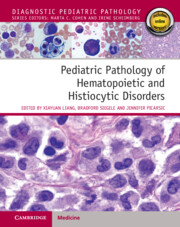Book contents
- Pediatric Pathology of Hematopoietic and Histiocytic Disorders
- Pediatric Pathology of Hematopoietic and Histiocytic Disorders
- Copyright page
- Epigraph
- Contents
- Contributors
- Section I General Hematology and Hematopathology
- Section II Non-Neoplastic Hematologic Disorders of Blood and Bone Marrow
- Section III Non-Neoplastic Disorders of Extramedullary Lymphoid Tissues
- Section IV Neoplastic Disorders of Bone Marrow
- Section V Mature Lymphoid Neoplasms
- Section VI Histiocytic Disorders and Neoplasms
- Chapter 24 Histiocytic Pathogenesis and Derivation
- Chapter 25 Identification of Macrophages and Dendritic Cells
- Chapter 26 Non-Neoplastic Accumulation of Histiocytes
- Chapter 27 Hemophagocytic Lymphohistiocytosis (HLH)
- Chapter 28 Histiocytic Inflammatory Neoplasms/Lesions
- Index
- References
Chapter 24 - Histiocytic Pathogenesis and Derivation
from Section VI - Histiocytic Disorders and Neoplasms
Published online by Cambridge University Press: 25 January 2024
- Pediatric Pathology of Hematopoietic and Histiocytic Disorders
- Pediatric Pathology of Hematopoietic and Histiocytic Disorders
- Copyright page
- Epigraph
- Contents
- Contributors
- Section I General Hematology and Hematopathology
- Section II Non-Neoplastic Hematologic Disorders of Blood and Bone Marrow
- Section III Non-Neoplastic Disorders of Extramedullary Lymphoid Tissues
- Section IV Neoplastic Disorders of Bone Marrow
- Section V Mature Lymphoid Neoplasms
- Section VI Histiocytic Disorders and Neoplasms
- Chapter 24 Histiocytic Pathogenesis and Derivation
- Chapter 25 Identification of Macrophages and Dendritic Cells
- Chapter 26 Non-Neoplastic Accumulation of Histiocytes
- Chapter 27 Hemophagocytic Lymphohistiocytosis (HLH)
- Chapter 28 Histiocytic Inflammatory Neoplasms/Lesions
- Index
- References
Summary
The term histiocyte (tissue cell) has evolved and is now often used as a collective term for two related groups of immune regulatory cells, the monocyte-macrophages and the dendritic cell (DC)–accessory antigen-presenting cells (1). The histiocytic proliferations of childhood encompass benign and malignant accumulations of monocyte-macrophages and hematopoietic-derived DC with a clinical spectrum of indolent to aggressive lesions. Although distinguishing between their reactive and neoplastic states can be challenging at times, molecular-based testing can help refine the diagnosis of neoplastic accumulations (see also Chapter 28) (2, 3).
- Type
- Chapter
- Information
- Pediatric Pathology of Hematopoietic and Histiocytic Disorders , pp. 307 - 309Publisher: Cambridge University PressPrint publication year: 2024

